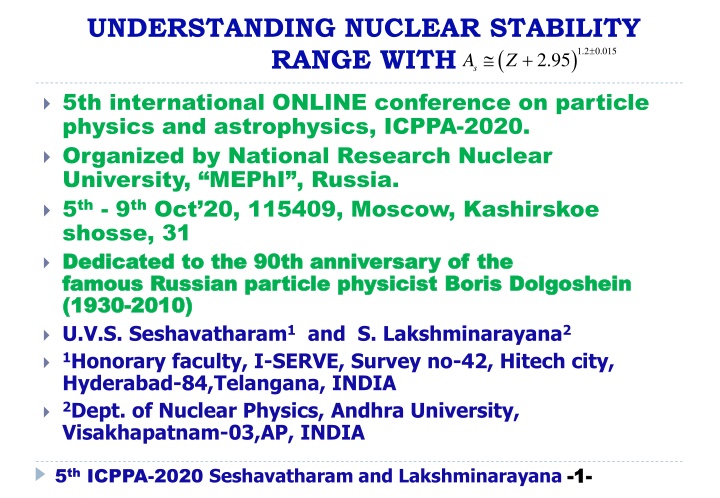
Exploring Nuclear Stability Range and Unification Models at ICPPA-2020
"Discover the inadequacy of current mass formulae in nuclear physics, delve into the secrets of nuclear binding energy and magic numbers, and explore the 4G model of final unification presented at the 5th International Online Conference on Particle Physics and Astrophysics (ICPPA-2020). Gain insights into the logic behind large atomic gravitational constants and the study of nuclear coupling constants. Join the discussion on the latest research and advancements in particle physics and astrophysics. Presented by Seshavatharam and Lakshminarayana from India."
Download Presentation

Please find below an Image/Link to download the presentation.
The content on the website is provided AS IS for your information and personal use only. It may not be sold, licensed, or shared on other websites without obtaining consent from the author. If you encounter any issues during the download, it is possible that the publisher has removed the file from their server.
You are allowed to download the files provided on this website for personal or commercial use, subject to the condition that they are used lawfully. All files are the property of their respective owners.
The content on the website is provided AS IS for your information and personal use only. It may not be sold, licensed, or shared on other websites without obtaining consent from the author.
E N D
Presentation Transcript
UNDERSTANDING NUCLEAR STABILITY RANGE WITH ( ) 1.2 0.015 + 2.95 sA Z 5th international ONLINE conference on particle physics and astrophysics, ICPPA-2020. Organized by National Research Nuclear University, MEPhI , Russia. 5th- 9thOct 20, 115409, Moscow, Kashirskoe shosse, 31 Dedicated to the 90th anniversary of the Dedicated to the 90th anniversary of the famous famous Russian particle physicist Russian particle physicist Boris (1930 (1930- -2010) 2010) U.V.S. Seshavatharam1and S. Lakshminarayana2 1Honorary faculty, I-SERVE, Survey no-42, Hitech city, Hyderabad-84,Telangana, INDIA 2Dept. of Nuclear Physics, Andhra University, Visakhapatnam-03,AP, INDIA Boris Dolgoshein Dolgoshein 5th ICPPA-2020 Seshavatharam and Lakshminarayana - -1 1- -
Inadequacy of Modern Semi Empirical Mass Inadequacy of Modern Semi Empirical Mass Formulae Formulae Physics and mathematics associated with fixing Physics and mathematics associated with fixing of the energy coefficients of semi empirical mass of the energy coefficients of semi empirical mass formulae are neither connected with residual formulae are neither connected with residual strong nuclear force nor connected with strong strong nuclear force nor connected with strong coupling constant. coupling constant. Since nuclear force is mediated via quarks and Since nuclear force is mediated via quarks and gluons, it is necessary and compulsory to study gluons, it is necessary and compulsory to study the nuclear binding energy scheme in terms of the nuclear binding energy scheme in terms of nuclear coupling constants. nuclear coupling constants. N. N. Ghahramany Ghahramany and team members have taken a and team members have taken a great initiative in exploring the secrets of nuclear great initiative in exploring the secrets of nuclear binding energy and magic numbers with reference binding energy and magic numbers with reference to quarks. to quarks. Very interesting point of their study is that - nuclear binding energy can be understood with two or three terms having a single (variable) energy coefficient. 5th ICPPA-2020 Seshavatharam and Lakshminarayana -2-
3 assumptions of 4G model of Final unification There exists a characteristic electroweak fermion of rest energy, Mw = 584.725 GeV. It can be considered as the zygote of all elementary particles. There exists a strong interaction elementary charge (es) in such a way that, its squared ratio with normal elementary charge is close to reciprocal of the strong coupling constant. Each atomic interaction is associated with a characteristic gravitational coupling constant. 5th ICPPA-2020 Seshavatharam and Lakshminarayana -3-
Logic behind large atomic gravitational constants When mass of any elementary particle is extremely small/negligible compared to macroscopic bodies, highly curved microscopic space-time can be addressed with large gravitational constants and magnitude of elementary gravitational constant seems to increase with decreasing mass and increasing interaction range. Corresponding relation is: G m 2 x c x 5th ICPPA-2020 Seshavatharam and Lakshminarayana -4-
Three atomic gravitational constants Gravitational constant associated with Gravitational constant associated with Electromagnetic Interaction Electromagnetic Interaction 2.374335 10 m kg sec e G 37 3 -1 -2 Gravitational constant associated with Strong Interaction 3.329561 10 m kg sec s G 28 3 -1 -2 Gravitational constant associated with Weak Interaction 2.909745 10 m kg sec w G 22 3 -1 -2 5th ICPPA-2020 Seshavatharam and Lakshminarayana -5-
Three important results associated with our model Newtonian Gravitational Constant 14 21 10 4 16 w e e N p s p m G m G G m c -11 3 -1 -2 6.679855 10 m kg sec G 30 2 2 Product of Reduced Planck s constant and speed of light c G M 2 w G M m w s w e Fermi s weak coupling constant 2 w 2 w 62 3 1.4402105 10 J.m G G M R F w ( ) 2 where, 2 R G M c w w w 5th ICPPA-2020 Seshavatharam and Lakshminarayana -6-
Strong Coupling Constant in 4G Model of Final Unification Strong coupling constant can be defined as, Strong coupling constant can be defined as, 2 3 p 2 p 2 s G m G m e e 1 s s 2 3 e c G m s e 3 p 2 p G m G m e e 1 s s s 3 e c G m s e 0.1151937 2.9463591 s se e 5th ICPPA-2020 Seshavatharam and Lakshminarayana -7-
Proton-Neutron stability relation Current Stability relation: A A Z ( ) 2 3 2 3 + + 2.0 2 2.0 0.0153 a a a A A c a where 0.71 MeV and 23.2 MeV a c a Proposed relation: s A ( ) 2 2 + + 2 4 2 0.0064 ) Z k Z Z Z ( 2 2 + + Let, where, = 2 2 A kx Z k Z x = s 2 and Z x G m m e m e s p c e s 0.001605 k m p e 5th ICPPA-2020 Seshavatharam and Lakshminarayana -8-
Mass number Mass number close to close to mean stability mean stability 204 207 210 213 216 219 222 226 229 232 235 238 241 245 248 251 254 257 261 264 267 271 274 277 281 284 287 291 294 297 301 304 308 311 315 318 322 325 Mass number Mass number close to mean close to mean stability stability 93 95 98 100 103 106 108 111 113 116 119 121 124 127 129 132 135 138 140 143 146 149 151 154 157 160 163 166 168 171 174 177 180 183 186 189 192 195 198 201 Mass number Mass number close to mean close to mean stability stability Proton Proton number number Proton Proton number number Proton number Proton number 81 82 83 84 85 86 87 88 89 90 91 92 93 94 95 96 97 98 99 100 101 102 103 104 105 106 107 108 109 110 111 112 113 114 115 116 117 118 41 42 43 44 45 46 47 48 49 50 51 52 53 54 55 56 57 58 59 60 61 62 63 64 65 66 67 68 69 70 71 72 73 74 75 76 77 78 79 80 2 3 4 5 6 7 8 9 10 11 12 13 14 15 16 17 18 19 20 21 22 23 24 25 26 27 28 29 30 31 32 33 34 35 36 37 38 39 40 4 6 8 10 12 14 16 19 21 23 25 27 29 31 34 36 38 40 43 45 47 49 52 54 56 59 61 63 66 68 71 73 75 78 80 83 85 88 90 -9-
Nuclear binding energy with one fixed energy coefficient and 4 simple terms Our simple relation: ( ) 2 A A ( ) ( ) s 1 3 1 0.00189 + 10.1 MeV B A A ZN A B 0 A A s can be called as the number of free or unbound nucleons. can be called as radial factor associated with nucleons. can be called as isotopic asymmetric term associated with mean stable mass number. s A ( ) 1 0.00189A ZN + 1 3 A ( ) 2 A A s 5th ICPPA-2020 Seshavatharam and Lakshminarayana -10-
Reference Semi empirical mass Formula Niels Walet (2001) P615: Nuclear and Particle Physics (UMIST, Manchester, UK) Chap.4 p33 2 ( ) Z A ( ) 2 3 15.36 16.32 0.6929 A A 1 3 MeV BE ( ) ( ) , , A N Z 2 ( ) / 2 A Z 11.32 90.46 A A 5th ICPPA-2020 Seshavatharam and Lakshminarayana -11-
Isotopic binding energy of Z=50 Mass number Mass number close to close to mean mean stability stability 116 116 116 116 116 116 116 116 116 116 116 116 116 116 116 116 116 116 116 116 116 116 116 116 Estimated Estimated BE BE (MeV) (MeV) Reference Reference BE BE (MeV) (MeV) Proton Proton number number Mass Mass Number Number Error Error (MeV) (MeV) 50 50 50 50 50 50 50 50 50 50 50 50 50 50 50 50 50 50 50 50 50 50 50 50 110 111 112 113 114 115 116 117 118 119 120 121 122 123 124 125 126 127 128 129 130 131 132 133 934.36 943.26 951.99 960.52 968.88 977.05 985.04 992.85 1000.47 1007.91 1015.17 1022.25 1029.14 1035.85 1042.38 1048.73 1054.89 1060.87 1066.67 1072.29 1077.72 1082.97 1088.04 1092.93 -0.44 -0.34 1.76 1.58 3.39 2.95 4.50 3.84 5.17 4.31 5.44 4.41 5.37 4.21 5.03 3.75 4.44 3.07 3.67 2.23 2.75 1.26 1.72 0.19 933.9 942.9 953.8 962.1 972.3 980.0 989.5 996.7 1005.6 1012.2 1020.6 1026.7 1034.5 1040.1 1047.4 1052.5 1059.3 1063.9 1070.3 1074.5 1080.5 1084.2 1089.8 1093.1 5th ICPPA-2020 Seshavatharam and Lakshminarayana -12-
Estimated binding energy at estimated As Proton Proton number number stability stability 8 16 123.61 13 27 225.35 18 38 325.98 23 49 424.97 28 61 530.85 33 73 634.36 38 85 735.42 43 98 842.16 48 111 945.94 53 124 1046.73 58 138 1152.07 63 151 1246.60 68 166 1352.31 73 180 1447.20 78 195 1545.23 83 210 1639.30 88 226 1735.56 93 241 1821.42 98 257 1909.00 103 274 1997.55 108 291 2081.14 113 308 2159.74 118 325 2233.36 Mass number Mass number close to mean close to mean Estimated BE Estimated BE (MeV) (MeV) FRDM(2012) FRDM(2012) (MeV) (MeV) 128.03 223.56 327.77 426.54 533.98 634.8 738.52 843.65 947.26 1046.7 1155.87 1244.88 1351.68 1445.18 1545.18 1644.11 1731.08 1818.2 1907.43 1997.07 2086.27 2163.9 2244.42 Error Error (MeV) (MeV) 4.42 -1.79 1.79 1.57 3.13 0.44 3.10 1.49 1.32 -0.03 3.80 -1.72 -0.63 -2.02 -0.05 4.81 -4.48 -3.22 -1.57 -0.48 5.13 4.16 11.06 5th ICPPA-2020 Seshavatharam and Lakshminarayana -13-
Mystery of the two numbers 0.0064 and 0.00189 With trial-error we noticed that, ( ) n 1 ( ) s 0.006457,0.0019 2 1 n = where, 1 and 2. n 5th ICPPA-2020 Seshavatharam and Lakshminarayana -14-
Fixed binding energy coefficient Binding energy coefficient can be expressed as follows: 2 1 4 s R 2 s e e 10.08 MeV B 0 4 R 0 0 0 0 where, 0.1152 and R 1.24 fermi 0 s 2 2 p 2 2 G m G m e e 1 s s p s , 1.24 fermi R 0 2 c c s ( ) ee 1 2 4 2 s B m c 0 p c 0 2 s 2 ( ) e 1 2 e 2 10.09 MeV m c p 4 4 c c 0 0 5th ICPPA-2020 Seshavatharam and Lakshminarayana -15-
Procedure for developing the relation ( Z ) 1.2 0.015 + 2.95 s A Starting from Z= 2 to 118, ( ) ln ln s A ( ) 2.0 to 1.21 ( ) Z ( ) ( ) 2.0 to 1.21 s A Z 5th ICPPA-2020 Seshavatharam and Lakshminarayana -16-
Graph for ln(As)/ln(Z) 2.00 (Z) ) ln(Z 1.90 ) and ln 1.80 (As) and 1.70 1.60 ln(As 1.50 1.40 of ln Ratio of 1.30 1.20 Ratio 1.10 1.00 2 8 26 62 98 14 20 32 38 44 50 56 68 74 80 86 92 104 110 116 Proton number Proton number 5th ICPPA-2020 Seshavatharam and Lakshminarayana -17-
Simplified relation with a power factor of 1.2 Let, se e 2.946359 2.95 1.20 e e 1.20 s + + 2.95 A Z Z s ( ) + ln 1.20ln 2.95 s A Z Number, 1.2 can be called as Power factor of Stability 5th ICPPA-2020 Seshavatharam and Lakshminarayana -18 -
Graph for ln(As)/ln(Z+2.95) 2.90 2.80 2.70 n(As) and ln(Z+2.95) ) and ln(Z+2.95) 2.60 2.50 2.40 2.30 2.20 2.10 2.00 1.90 Ratio of ln(As 1.80 1.70 1.60 Ratio of l 1.50 1.40 1.30 1.20 1.10 1.00 102 106 110 114 118 50 94 6 10 14 18 22 26 30 34 38 42 46 54 58 62 66 70 74 78 82 86 90 98 2 Proton number Proton number 5th ICPPA-2020 Seshavatharam and Lakshminarayana -19-
Conclusion Considering the observed data, we consider a range of 1.2 0.015 with the relation, 2.95 Z + 1.20 0.015 s A With further study, range can be modified for a better understanding or better fit. Proceeding further, fundamental things can be understood in a unified approach for High energy nuclear physics and low energy nuclear physics. 5th ICPPA-2020 Seshavatharam and Lakshminarayana -20-
Proton number 118 117 116 115 114 113 112 111 110 109 108 107 106 105 104 103 102 101 100 99 98 97 96 95 94 93 92 91 90 Observed range of isotopes 294 295 293 294 290 294 287 290 284 290 278 290 277 286 272 286 267 281 266 282 263 277 260 278 258 271 255 270 253 270 254 266 250 262 248 260 241 260 240 258 240 256 236 254 236 252 232 249 232 247 228 244 226 242 223 240 221 238 Observed range of main isotopes 294 295 293 294 290 294 287 290 284 290 278 290 283 286 279 286 279 281 274 282 269 271 267 278 265 271 262 270 261 267 254 266 253 259 256 260 252 257 252 255 248 254 245 249 242 250 241 243 238 244 235 239 232 238 229 234 227 234 Estimated stability range 294 339 291 336 288 332 285 329 282 326 279 322 277 319 274 315 271 312 268 309 265 305 262 302 259 299 257 295 254 292 251 289 248 285 245 282 243 279 240 276 237 272 234 269 232 266 229 262 226 259 223 256 220 253 218 249 215 246 -21-
References Royer G, Subercaze A 2013 Coefficients of different macro-microscopic mass formulae from the AME2012 atomic mass evaluation. Nuclear Physics A 917: 1-14 Cht Mavrodiev S, Deliyergiyev MA 2018 Modification of the nuclear landscape in the inverse problem framework using the generalized Bethe-Weizs cker mass formula. Int. J. Mod. Phys. E 27: 1850015 Xia, X. W., Lim, Y., Zhao, P. W., Liang, H. Z., Qu, X. Y., Chen, Y., & Meng, J. 2018. The limits of the nuclear landscape explored by the relativistic continuum Hartree Bogoliubov theory. Atomic Data and Nuclear Data Tables, 121, 1-215. M ller, P., Sierk, A. J., Ichikawa, T., Sagawa, H. 2016. Nuclear ground-state masses and deformations: FRDM 2012. Atomic Data and Nuclear Data Tables, 109, 1-204. Ghahramany N, Sh Gharaati, Ghanaatian M, Hora H 2011 New scheme of nuclide and nuclear binding energy from quark-like model. Iranian Journal of Science & Technology. A3: 201-208 Ghahramany, N., Gharaati, S., & Ghanaatian, M. 2012 New approach to nuclear binding energy in integrated nuclear model. Journal of Theoretical and Applied Physics, 6(1), 3. Seshavatharam UVS and Lakshminarayana S. 2019 On the role of large nuclear gravity in understanding strong coupling constant, nuclear stability range, binding energy of isotopes and magic proton numbers A Critical Review. Journal of Nuclear Physics, Material Sciences, Radiation and Applications, 6(2), 142-160 5th ICPPA-2020 Seshavatharam and Lakshminarayana -22-
Continued Seshavatharam UVS and Lakshminarayana S. 2019 Role of Four Gravitational Constants in Nuclear Structure. Mapana-Journal of Sciences, 18(1), 21-46. Seshavatharam UVS and Lakshminarayana S. 2020 Implications and Applications of Fermi Scale Quantum Gravity. International Astronomy and Astrophysics Research Journal. 2(1): 13-30 Seshavatharam UVS and Lakshminarayana S. 2019 On the Role of Squared Neutron Number in Reducing Nuclear Binding Energy in the Light of Electromagnetic, Weak and Nuclear Gravitational Constants A Review. Asian Journal of Research and Reviews in Physics, 2(3): 1-22. Seshavatharam UVS, Lakshminarayana S. 2019 On The Role of Nuclear Quantum Gravity In Understanding Nuclear Stability Range of Z = 2 to 118. J. Nucl. Phys. Mat. Sci. Rad. A 7(1): 43 51. Seshavatharam UVS, Lakshminarayana S. 2020 Significance and Applications of the Strong Coupling Constant in the Light of Large Nuclear Gravity and Up and Down Quark Clusters. International Astronomy and Astrophysics Research Journal 2(1):56-68. Seshavatharam UVS, Lakshminarayana S. 2020 Understanding nuclear stability and binding energy with powers of the strong coupling constant. Mapana Journal of Sciences. 19(1), 35-70. 5th ICPPA-2020 Seshavatharam and Lakshminarayana -23-
Continued Seshavatharam UVS and Lakshminarayana S. Semi Empirical Derivations Pertaining to 4G Model of Final Unification. International Astronomy and Astrophysics Research Journal 2(1): 69-74 (2020) Tanabashi et al 2018 Review of Particle Physics: Particle Data Group. Phy. Rev. D. 98 Mohr P. J, Newell D. B and Taylor B. N. 2014 CODATA recommended values of the fundamental constants: Rev. Mod. Phys. 88, 035009 Junfei Wu, Qing Li, Jianping Liu, Chao Xue, Shanqing Yang, Chenggang Shao,Liangcheng Tu, Zhongkun Hu, and Jun Luo. 2019 Progress in Precise Measurements of the Gravitational Constant. Ann. Phys. (Berlin) 531, 1900013 https://en.wikipedia.org/wiki/Table_of_nuclides; https://en.wikipedia.org/wiki/Stable_nuclide; Giuliani Samuel A, Matheson Zachary, Nazarewicz Witold, Olsen Erik, Reinhard P, Sadhukhan Jhilam, Schuetrumpf Bastian, Schunck Nicolas, Schwerdtfeger Peter. 2019 Colloquium: Super heavy elements: Oganesson and beyond. Rev. Mod. Phys. 91: 011001 Gottfried M nzenberg (2018) Super Heavy Elements - experimental developments. EPJ Web of Conferences 182: 02091 5th ICPPA-2020 Seshavatharam and Lakshminarayana -24-
We are very much thankful to ICPPA-2020 committee. Thank You for your kind attention. Emails: seshavatharam.uvs@gmail.com (and) lnsrirama@gmail.com 5th ICPPA-2020 Seshavatharam and Lakshminarayana -25-




